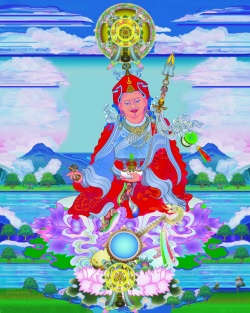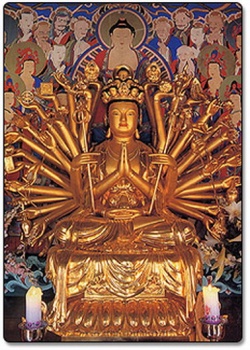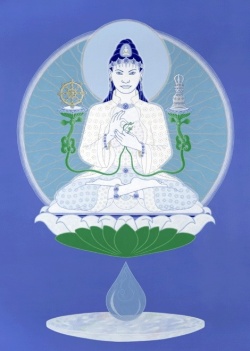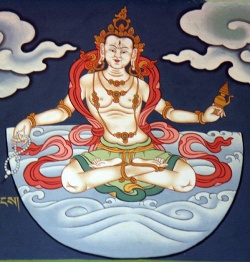The Psychology of Buddhist Tantra by Rob Preece
Introduction
When we enter the world of Tantra, we may need to loosen some of our preconceptions about the nature of reality. We begin to inhabit a twilight world where the distinctions between the material and the symbolic are less defined. We discover that psyche and soma, the unconscious and matter, are in an intimate inter-relationship. The tantric view of reality does not make such solid differentiation between them; they are simply two reflections of the same ultimate nature. In the West, we habitually make a clear distinction between spirit and matter, whereas, in the East, these two are not separated.
Tantra, or Vajrayana, has emerged from a culture where nature is still animated. Spirits still inhabit rocks and rivers; demons and goblins live in wild places, and interfere with the lives and health of those who disturb them. People make offerings to the local guardians and protectors to maintain the fertility of their crops and the security of their households, and sickness is seen as the interference of spirits. As Westerners engaging in Tantra, we may find it convenient to overlook this animism as superstition or primitive medieval belief. We would, for example, go to a doctor when we were sick, rather than consider pacifying an interfering spirit.
Tantra has thus become sanitized, and is largely practiced in the West as a series of sophisticated practices performed in the contained environment of the local temple. This may make Tantra more accessible to Western taste, as many aspects of the tantric world-view are alien to our cultural background, but it is not how tantric adepts, particularly in India, would have pursued their practice. They were often found in wild hostile places, such as cremation grounds, mountain caves and forests; environments where the elemental energies they were awakening and relating to were alive and potent.
We cannot assume that Tantra will find an easy resonance in the Western psyche when our cultural psychological background is so different, even if we feel an attraction. So we require a bridge between the complex practices of Tantra and our Western disposition for psychological understanding. The work of Jung has much to offer in this respect, throwing light on some of the more obscure aspects of these esoteric practices.
I first encountered the work of C.G. Jung while I was at university, but the importance of the link between Tantra and the work of Jung was made in 1976, when my teacher, Lama Thubten Yeshe, was visiting the UK, and introduced many of his students to the Jungian sand-play analyst Dora Kalff. This link was further deepened during retreat in India from 1980 onwards, when I was fortunate enough to have with me several volumes of Jung’s Collected Works, including Psychology and Alchemy. This somewhat unusual opportunity gave me the chance to explore tantric practice while drawing connections to Jung’s ideas. The parallels between the two seemed remarkable, and gave me a clear feeling for the alchemical nature of the tantric path. Jung’s understanding seemed to open up psychological meaning within tantric practice helping to bridge two worlds. In exploring Tantra from a more psychological perspective, it also seemed possible that Tantra itself could broaden or deepen our understanding of Western archetypal psychology.
When I eventually returned to the West in 1985, underwent training as a psychotherapist, and began to teach workshops on comparative Jungian and Buddhist psychology, the implications of a psychological basis for the practice of Tantra became more and more relevant. It became apparent to me that the practice of Tantra needs a fertile ground in which to grow. It relies less on intellectual and philosophical knowledge than on an innate trust in the intuitive and creative faculties of the mind. The language of Tantra is not the abstract intellectual concepts of philosophy, but the language of symbol and myth, which follow a different rationale. The poetic metaphorical reality of Tantra takes the power of symbol to perhaps its most refined potential. Jung once said that in the east they reject fantasy not because it is irrelevant and childish as we often consider in the west, but because its essence has long ago been transformed into a religion.
Mythical truth and historical truth become subtly interwoven in Tantra in a way that tries to express the inner meaning and symbolic nature of our experiences. The extraordinary events described in the biographies of tantric adepts like Padmasambhava, Milarepa, and Gesar show how Tantra inhabits a twilight zone where our familiar, material, outer world and the inner world of the psyche begin to merge. The outer world becomes suffused with inner reality.
Tantra focuses our attention on the underlying vitality and energy of our aliveness. It brings us into contact with the subtle influences that shape and motivate the dynamics of life, thus inevitably has been linked with sexuality. Consequently many people have seen this as the central practice of Tantra. Unfortunately, the popularization of “tantric sex” has lead to much misunderstanding. When placed in the wider context of this profound path, the energy of our sexuality may well be an aspect of the creative process of Tantra, but it bears little relationship to the exotic sexual possibilities some Westerners like to imagine. Our sexuality is only one expression of the subtle forces that flow through our lives, bringing vitality and creativity. In Tantra, this vitality is seen as the root of transformation in order to awaken our full potential.
The tantric path brings us back into relationship with the source of the vitality of our lives, and then offers a vehicle for its creative manifestation. This source is intrinsically connected to our physical body, but is visualized in the aspect of a deity. There are many deities, but tantric practitioners need not practice them all. Rather, they attune to the deity or deities that are constitutionally the most transformative for them. A deity is not like an external god; it arises as a manifestation of the mind’s primordial clear nature. Our true relationship to the deity comes, therefore, from within, and is felt as a deep inner resonance, or as an energetic quality that pervades the body. Once this is awakened, practicing just one deity allows us to experience the underlying source of them all.
The Tibetan word for Tantra is gyu, a term which is often translated as “continuity,” but which can also be understood to mean “the process of transformation.” Tantra is the unfolding of a creative process, which occurs moment by moment in the act of manifestation and transformation. In this sense, we continually experience the process of creative transformation in every aspect of our lives. When the process unfolds naturally, as an expression of our true nature, we experience a flow of vitality in all we do. But when this process becomes stuck or blocked, we experience varying degrees of dis-ease and suffering. As Jung pointed out, the gods that inhabit the underworld of the psyche “have become diseases.”
Each of us has the innate potential to awaken fully, and to give individual expression to our true nature in our lives. This potential is the seed of our buddha nature, which, once awakened and allowed to manifest, can creatively enrich our lives. The transformative nature of tantric practice is like the yogurt culture that turns milk into yogurt. Activating the deity within the psyche of a practitioner gradually awakens and brings to manifestation the full potential within.
Tantra has more in common with the creative arts than with philosophy or science. Its visionary nature is intimately linked with a process that brings deep inner wisdom into expression, similar to that which we see in great works of art. The essential principle of Tantra can live through an individual in different ways, and the tantric adept is often a mixture of healer, shaman, artist and medieval alchemist.
In this book I have tried to bring out some of the elements of an alchemical process, as explored by Jung, which have a direct bearing on our understanding of the transformation process of Tantra. The structure I have used reflects something of this approach. In Part I have introduced some of the necessary preliminary conditions for entering into the process of Tantra, as a kind of alchemical apprenticeship. Here I will look at the need for a sound psychological ground, and also the significance of a relationship to some form of guide or mentor who holds the process.
In Part II, I introduce some of the significant elements involved in actually embarking upon the process of Tantra as we place ourselves within the alchemical vessel. Here I explore the nature of that vessel, and those aspects of ourselves that are the essential ingredients of transformation.
Part III then looks in more depth at the actual processes that are practiced within this vessel. We look at the psychological nature of deity practice as a means of transformation, drawing particularly on Jung’s insights.
Lastly, Part IV explores the completion of the alchemical process and its implications for us as we apply our experiences out in the world. Here I try to show how the essential principle of Tantra is to encourage the expression of our true nature through the creative process. Once we are attuned to it, this creative principle can then be present in every aspect of our lives.
Detailed descriptions of tantric practices can be found in many of recent translations of and commentaries on Tibetan tantric texts, and will not be explained here. (See, for example, Stephen Beyer’s The Cult of Tara; Gavin Kilty’s translation of the Ornament of Stainless Light; and Lama Yeshe’s Tantric Path of Purification.) We will rather explore the underlying psychological processes intrinsic to tantric practice, and look at some of the difficulties Westerners might encounter when meeting this Eastern tradition. Much of the work here has come from my own struggles and insights while attempting to bring tantric practice into my life.
I have also drawn on my experience as a psychotherapist and meditation teacher over the past twenty years, and I focus on a process that is relevant to both men and women. However, I have made no attempt here to address specific issues relating to women’s relationships to Tibetan Buddhism, or to Tantra in particular.
It has become increasingly apparent that some of the problems that arise in integrating the practice of Tantra are a reflection of our own psychological and cultural dispositions, while others arise from the fact that Tantra has been colored for so long by a particularly influential Tibetan culture. Much is owed to the Tibetans for preserving this tradition. To become genuinely integrated into the Western psyche, however, Tantra needs to be freed from some of its Tibetan influence. What I have attempted to do here is to remain true to the essential principles at the heart of tantric practice, and bring to light its psychological significance as a process of creative transformation.





